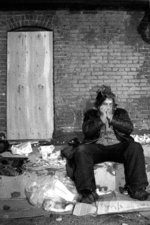Homeless families make up nearly 50 percent of Denver's homeless population, but only 15 percent of shelter beds accommodate families. Is enough being done to keep families together?
By Kristin Pazulski
 Karla Hood and her 20-year-old son Karron have been living together in a small motel room off Colfax Avenue since February.
Karla Hood and her 20-year-old son Karron have been living together in a small motel room off Colfax Avenue since February.
Their home is in the Volunteers of America’s (VOA) Family Motel. During the day, the sun glitters off the 70s-style lettering of the sign that still stands from the motel’s former life as Aristocrat Motel. In their room, there are two beds, a closet, a bathroom, two nightstands and a chest of drawers. The room is strewn with belongings that once filled their two-bedroom apartment, but are now confined to the two-bed motel room.
Karla, 48, and Karron had to leave their home of 20 years in February when the landlord of their subsidized housing in East Denver refused to renew Karla’s lease. “It was such a last minute situation,” she said. “I had to leave behind about 75 percent of our stuff. I couldn’t afford the storage. I just let it go. I cried a lot and prayed a lot.”
Published: April 2009 Vol. 13 Issue 3
photography & text by Ross Evertson
 Earthship designed and built by Joe Callahan of Boulder, Colorado. Photos by Ross Evertson.
Earthship designed and built by Joe Callahan of Boulder, Colorado. Photos by Ross Evertson.
I was raised in the carpet and drywall world of suburban Denver. The homes of my friends all looked and felt so similar to my own, each one was like a visit to a parallel universe (some of them even shared the exact same floor plan, and everyone decorated the same way—the primary difference was the odor, if the parents smoked, or if there was a baby). There was something comforting to the sameness at that age, but as I got older that sameness became almost depressing and it was rare for me to ever find that level of comfort in the home of anyone else, friend or stranger.
It was particularly bizarre, then, when I first stepped into an earthship. It did not look like any home I had ever been in before. Beneath the iconic south-facing floor to ceiling windows is an indoor garden, fed by greywater from the sinks and shower. The soft forms of the structure flow all around. As organic as the stucco walls feel, they are covering a traditional earthship building material—used automobile tires filled with tightly compacted dirt.
Published: April 2009 Vol. 13 Issue 3
photography and text by D. Glies Clasen
EDAR photographs by Julie Yurth Himot
 Mark Hedrick plays his harmonica trying to relax after a long day on the streets.Each night around 9 or 10, the traffic slows, and most weeknights, the city falls into a slumber.
Mark Hedrick plays his harmonica trying to relax after a long day on the streets.Each night around 9 or 10, the traffic slows, and most weeknights, the city falls into a slumber.
That’s about the time the homeless men and women in Denver begin moving toward their campsites.
They set up their bivouacs, temporary encampments under little or no shelter.
The lucky ones might have a tent or roof.
